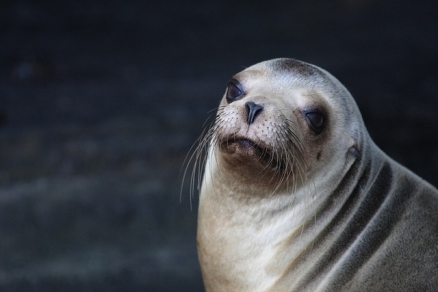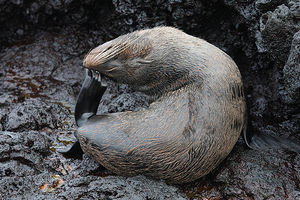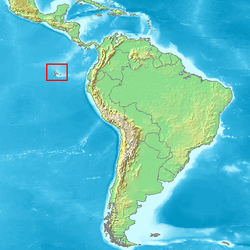Galapagos fur seal
The Galápagos fur seal (scientific name: Arctocephalus galapagoensis) is one of 16 species of marine mammals in the family of Eared seals which include sea lions and fur seals. Together with the families of true seals and Walruses, Eared seals form the group of marine mammals known as pinnipeds.
Eared seals differ from the true seals in having small external earflaps and hind flippers that can be turned to face forwards. Together with strong front flippers, this gives them extra mobility on land and an adult fur seal can move extremely fast across the beach if it has to. They also use their front flippers for swimming, whereas true seals use their hind flippers.
Like other Eared seals, the male Galápagos fur seal is considerably larger than the female.
Like other fur seals, the Galápagos fur seal was long hunted for its skin and oil and is now largely protected. By the early twentieth century, the Galápagos fur seal was believed to be extinct, until a small colony was discovered in 1932-33. It is still considered an endangered species.
The Galápagos fur seal is now considered by some researchers as a subspecies to the South American fur seal. (Brunner, Society for Marine Mammalogy)
|
Conservation Status |
|
Scientific Classification Kingdom: Anamalia (Animals) |
|
Common Names |
Contents
Physical Description
The scientific name of this marine mammal, Arctocephalus, comes from Greek words that mean 'bear headed', and with its short, pointed muzzle, little button-like nose and fairly large eyes, the Galápagos fur seal does indeed bear a resemblance to its land-dwelling, carnivorous ancestors. The coat of this fur seal varies from dark brown to dark grey, with light-tipped, longer guard hairs giving a grizzled appearance. Male Galápagos fur seals also have a mane of slightly longer hairs, from the top of their head to their shoulders. Both the muzzle and the fur on the undersides is paler, with females and subadults having a pale greyish-tan chest and rusty-tan belly, and the skin on the flippers is blackish. Galápagos fur seal pups have a blackish-brown coat, sometimes with greyish or whitish margins around the mouth and nose.
Male Galápagos fur seals are 154 cm long, while the females are about 120 cm long. Although there is a 30 cm difference, it is the least sexually dimorphic of otariids in size and in color. Dorsal body surface is gray-brown, the venter is light tan. Arctocephalus galapagoensis is the smallest of the fur seals, possibly an adaptation to the warm ambient and aquatic temperatures of their tropical habitat.
Reproduction
Females are able to have offspring by their fifth year. Pupping takes place in the cool season beginning in August and lasting until November. Gestation is approximately one year, however, the existence of delayed implantation in this species implies that development time may be less than one year. The unusual birth time in this species is believed to be due to "distribution at low latitudes, a more favourable climate throughout the year, and less pronounced seasonal variation in marine productivity than found in temperate and arctic waters. Females go into estrus 8 days after giving birth, and mate during lactation, which lasts from 1-2 years. Peak mating time is during the month of October. If a female gives birth to another pup the next year, it has a 50% chance of survival. The year old pup may kill the new pup or lack of resources may result in their starvation. Female Galápagos fur seals produce a maximium of 5 offspring in their lifetime.
On the rocky shores of the Galápagos Islands, six to ten Galápagos fur seals may occupy an area of about 100 square metres. Grouping together in this manner may be largely due to the rarity of suitable rocky sites, but it also has the benefit of females being less vulnerable to predation or harassment when in large groups. Breeding males establish larger territories, around 200 square metres, which encompass a number of females.
The breeding season lasts from mid-August to mid-November, when the cooler temperatures mean less heat stress and a greater availability of prey. A peak of births occurs in the last week of September or the first week of October, when females give birth to a single pup that has been carried for eight to twelve months. For the first five to ten days, the mother will stay with her newborn, but after this period, she alternates one to three days of feeding at sea with one to two days ashore with the pup. The pup is nursed for two to three years, sometimes even longer.
Just eight days after giving birth, the female mates. Being a polygynous mammal, one male may mate with between six and sixteen females within his territory. The rough terrain and large size of the male's territory means that it can be difficult to successfully defend all the females within the area, and a rival male may sometimes invade and mate with a female. Defending a territory with threats and fighting can be tiring work, so the male can often be seen cooling off in the sea at midday.
Although all females mate shortly after giving birth, only a small percentage will give birth the following year if they are still feeding a pup. If a pup is born to a female that is still feeding a pup from the previous year, the newborn often starves, or is occasionally killed by the older sibling. Females mature at three to four years of age, while males become territorial breeding bulls between seven and ten years old.
While the Galápagos fur seal is capable of diving to much greater depths, it mainly undertakes short dives to between 10 and 50 metres, where it feeds on a variety of fish and small squid
Lifespan
Little is known about the lifespan of the Galápagos fur seal, but it is generally believed that they live up to about 20 years.
Behavior
The Galápagos fur seal is the most terrestrial species of the family Otariidae, spending only 70% of their life in the water. Females dive for an average of 16.4 hours to a depth of no more than 30 meters at night, but deeper dives have been recorded. Foraging trips are reported to be correlated in duration with the cycle of the moon, lasting 50-70 hours at the time of the new moon but only 10-20 hours at the time of the full moon. During the warm months, females will repeat a foraging cycle of 4-6 days in the water and 1 day on land. After giving birth, females will leave their pups for 1-3 days to dive for food then 1-2 days are spent with the offspring. Pups do not become independent until their 2nd year, and sometimes not until their third. Adult males hold territories that can extend 200 square meters. Males defend these territories with high levels of aggression. Death rate for fighting males is 30% annually. Females hold very small areas, compared to other fur seals, of approximately 100 square meters. They are a polygynous species and males do not offer care for the offspring. Males do not feed while they are defending their territories, and will not abandon them until they have used all of their stored energy and have no choice but to feed.
These territories encompass water and rough terrain with overhangs to provide cooling. Other seals do not occupy this type of terrestrial habitat, most other seals prefer beaches.
To keep cool, seals will move to tide pools and wet themselves. Females have to teach this thermoregulatory strategy to their pups, or the newborns will suffer from overheating. It is very important at this latitude to keep internal temperatures to approximately 37.7 degrees C, therefore these seals have evolved methods to accomplish this. They utilize their environment for shade and water cooling, and have a reduced body size to release heat quickly. They also sweat, depending on individual hydration. Much heat loss is controlled internally by the cardiovascular system in that blood flow is directed away from, or toward, flippers depending on whether the seal is too cold or too warm, respectively.
Distribution
The Galápagos fur seal is endemic to the Galápagos Islands, where it is widely distributed. The main colonies occur on the western islands of the archipelago, with Isla Fernandina and Isla Isabela holding the largest populations.The Galápagos fur seal is found only in the Galápagos Islands, they do not migrate.
Habitat
When ashore, the Galápagos fur seal prefers rocky areas where it can seek shelter from the sun under ledges and between large boulders. Galápagos fur seals live only on the Galápagos Islands and in the surrounding waters. Air temperature is fairly constant year round at an average of 23.8 degrees C.
Food Habits
The Galápagos fur seal feeds on fish and cephalopods.
Conservation Status
The Galápagos fur seal is fully protected by the Galápagos National Park Service under Ecuadorean law. It will also benefit from the management of the Galápagos Islands and the surrounding waters as a national park and marine reserve. As one of the first sites to be designated a Natural World Heritage Site, the recognition of the Galápagos' incredible and unique ecosystem will hopefully ensure the preservation of the islands' fauna and flora for generations to come.
During the nineteenth century, the Galápagos fur seal was severely impacted by the large-scale commercial seal hunting that was rampant at the time. By the early 1900s it was said to be extinct due to overhunting for fur, but a population was found in 1932-33. The population had increased to between 30,000 and 40,000 by 1989. Ecuador reports that feral dogs on some of the 15 Galápagos Islands are a threat to current seal populations.
Further Reading
- Arctocephalus galapagoensis Heller, 1904 encyclopedia of Life (accessed April 3,2009)
- Arctocephalus galapagoensis, Poloskey, T., 2000, Animal Diversity Web (accessed April 3, 2009)
- Galápagos fur seal, Catalogue of Life (accessed November 24, 2009)
- Galapagos fur seal, Seal Conservation Society (accessed April 3, 2009)
- The Pinnipeds: Seals, Sea Lions, and Walruses, Marianne Riedman, University of California Press, 1991 ISBN: 0520064984
- Encyclopedia of Marine Mammals, Bernd Wursig, Academic Press, 2002 ISBN: 0125513402
- Marine Mammal Research: Conservation beyond Crisis, edited by John E. Reynolds III, William F. Perrin, Randall R. Reeves, Suzanne Montgomery and Timothy J. Ragen, Johns Hopkins University Press, 2005 ISBN: 0801882559
- Brunner, S. 2004. Fur seals and sea lions (Otariidae): identification of species and taxonomic review. Systematics and Biodiversity 1:339—439.
- Committee on Taxonomy. 2009. List of marine mammal species and subspecies. Society for Marine Mammalogy, www.marinemammalscience.org, consulted on May 17, 2011.
- Walker's Mammals of the World, Ronald M. Nowak, Johns Hopkins University Press, 1999 ISBN: 0801857899
- Galapagos fur seal, MarineBio.org (accessed April 3, 2009)
- Gentry, R., G. Kooyman. 1986. FUR SEALS: Maternal strategies on Land and Sea . New Jersey: Princeton University Press.
- Limberger, D., F. Trillmich, H. Biebach, R. Stevenson. 1986. Temperature regulation and microhabitat choice by free-ranging Galapagos fur seal pups (Arctocephalus galapagoensis). Oecologia , 69: 53-59.
- Trillmich, F., D. Limberger. 1985. Drastic effects of El Nino on Galapagos pinnipeds. Oecologia , 67: 19-22.
- Trillmich, F. 1984. The Natural History of the Galapagos fur seal, Arctocephalus galapagoensis, Heller.. Pp. 215-223 in R. Perry, ed. Key Environments: Galapagos . Oxford: Pergamon.
- Trites, A. 1990. Thermal Budgets and climate spaces: the impact of weather on the survival of Galapagos (Arctocephalus galapagoensis Heller) and northern fur seal pups (Callorhinus ursinus L.). Functional Ecology , 4: 753-768.



